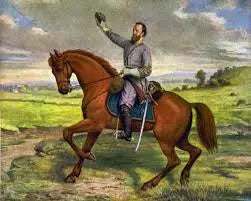
Did you know that in the Civil War, General Stonewall Jackson walked around with his right hand in the air to balance the blood in his body? Because he was right-handed, he thought that his right hand was getting more blood than his left, and so by raising his hand, he’d allow the excess blood to run into his left hand. He also never ate food that tasted good, because he assumed that anything that tasted good was completely unhealthy.
During the Civil War, glasses with colored lenses were used to treat disorders and illnesses. Yellow-trimmed glasses were used to treat syphilis, blue for insanity, and pink for depression. Thus we get the term, to see the world through rose-colored glasses.
Centuries before and decades after the Civil War, including the war itself, doorways were wide, not because of the width of women’s skirts, but so coffins could be passed through, with a pallbearer on either side.

Did you know that the average American in the 1860’s could not afford to paint his house, and a painted house was a sign of affluence? In order to keep up appearances, they used cedar clapboards.
Did you know that when a woman mourned for her husband in the 1860’s, she spent a minimum of two-and-a-half years in mourning? That meant little or no social activities: no parties, no outings, no visitors, and a wardrobe that consisted of nothing but black. (Shame on Scarlet O’Hara) The husband, when mourning for his wife, however, spent three months in a black suit.
Surgeons never washed their hands after an operation, because all of the blood was assumed to be the same.
Did you know that during the Victorian era, the dead were either laid out in their parlors, or, as the Southerners preferred, in their bedrooms? There was no such thing as a funeral home; death was a part of life, and the dead remained in the house up until they were buried. The tradition of flowers around the coffin comes from the Victorians trying to hide the scent of the deceased. Did you know that when a child died, parents would have a photograph taken of the child? They wanted to preserve the memory for as long as possible. A lot of photographs taken of sleeping children are actually of deceased sons or daughters.
After the Battle of Gettysburg, the discarded rifles were collected and sent to Washington to be inspected and reissued. Of the 37,574 rifles recovered, approximately 24,000 were still loaded; 6,000 had one round in the barrel; 12,000 had two rounds in the barrel; 6,000 had three to ten rounds in the barrel. One rifle, the most remarkable of all, had been stuffed to the top with twenty-three rounds in the barrel.

Did you know that President Lincoln had a mild form smallpox (varioloid) while he gave the Gettysburg Address. On the train back to Washington he quipped, “Now I have something that I can give everybody.”
Did you know that President Lincoln’s favorite tune was “Dixie”?
The Civil War was also known as The Brothers’ War, the War for the Union and the War of the Rebellion. General Nathan Bedford Forrest, CSA, had twenty-nine horses shot from beneath him during the war years.

Lastly, this is my favorite. I laughed for a while about this. One of the most popular questions park rangers get when giving tours around Civil War battlefields is: “Did the soldiers have to fight around all of these monuments?” They could only smile and say yes: They knew exactly were to die.
Article courtesy of the “Bowling Banner,” Pvt. Wallace Bowling Camp # 1400, Sons Of Confederate Veterans, Post office Box 2355, La Plata, MD 20646

